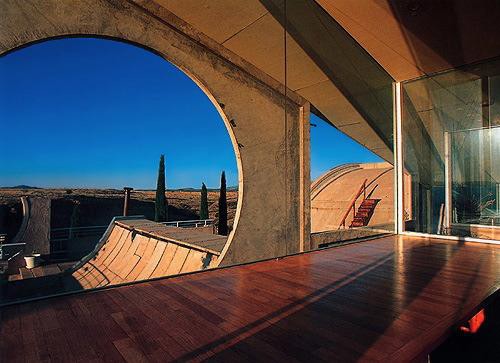CITY OF IDEAS
Arcosanti
THE FUTURE MAY BE HERE

You have never seen anything like Arcosanti.
It is an experimental city-of-the-future located in the Arizona desert, about 60 miles north of Phoenix on Highway 17. Arcosanti’s main buildings hang over a canyon wall like one of those hooked signs hanging off a bookshelf (zoning in the desert is a little lax). It has domes, giant greenhouses, huge circular windows that capture sunlight efficiently. The residents, who are always building some cool new element of the ever-developing city, are currently contemplating an
“energy apron” of inclined terraces and a bridge that doubles as a sundial. It’s a city of new ideas.
Founder and visionary architect behind the city, Paolo Soleri directed Arcosanti’s development with his weirdo aphorisms (“The Lean Linear City … is like witnessing a new branch of the human genome”). Today the community of 7,000 encourages visitors and runs itself like an open workshop: You can stay, you can work there, you can participate in seminars.
An Arcosanti Café serves European cuisine, musical guests and panelists provide cultural enhancement, and you can walk around the City of Tomorrow. It looks different from most places you will ever visit, with vaulting arches, organic gardens and all-earthen materials, unusual lines to all of the architecture. There is no single approach: Arcosanti is a sort of work in progress, a mixture of styles and ideas.
Financed through a combination of grants, contributions, private developers, and the sale of souvenir bells, the existing structure represents only 10 percent of what has been envisioned.
The Lean Linear City … is like witnessing a new branch of the human genome.
One day, Arcosanti hopes to encompass 4,000 acres of complex urban structures, complete with high-tech solar greenhouses. Philadelphia, London and Tokyo, stay tuned – these experiments could very well predict your futures.
One basic premise, as well as I can state it, is that we are way too sloppy in the use of natural resources when we create cities. Since the growth is more or less random, we spread out too much. In a ‘miniaturized’ city, we can gain an enriched living style with far less consumption. More importantly, our spiritual life is freed when the habitat we live in has the proper relationship to nature.
Experts from Egyptologists to software engineers to astrophysicists and sociologists contribute to the cloisters which make up the greater Arcosanti organism.
Arcosanti has its roots in modernist theory. A French theorist named Le Corbusier rediscovered how the Greeks set their buildings in relation to the natural surroundings. Architect Alvar Aalto suggested designs that use local material and using these to mirror the natural world around the homes. Soleri sees cyberworkers equally comfortable in his community as farmers. His “urban frugality” idea leads him into some kind of transforming and monastic lifestyle in a way I cannot quite follow, but whatever the theories behind Arcosanti, you have never seen anything quite like it.
Sections of this first appeared in my column for the North County Times.
# # #